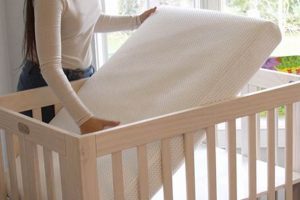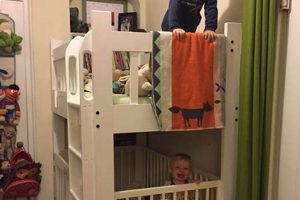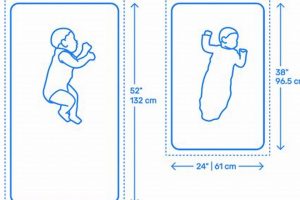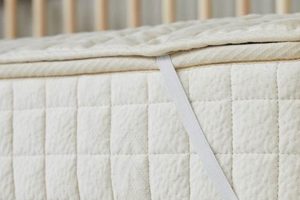The dimensions of a crib mattress refer to its length, width, and thickness. These dimensions are crucial for ensuring the mattress fits safely and snugly within a standard crib frame. Deviation from established dimensions can present safety hazards.
Adherence to standardized dimensions is paramount for infant safety. A properly sized mattress eliminates gaps between the mattress and the crib frame, mitigating the risk of entrapment. Historically, variations in crib mattress sizes led to increased incidents of infant injury, prompting the establishment of safety standards to regulate manufacturing.
Therefore, understanding the specifics of crib mattress sizing, including standard dimensions and factors influencing size variations, becomes essential for parents and caregivers seeking to provide a safe sleeping environment. This article will delve into these specific dimensions and related considerations.
Crib Mattress Measurement Considerations
Ensuring a safe sleep environment for an infant requires careful attention to detail. The correct dimensions of the sleep surface are critical. The following points offer important considerations regarding those measurements.
Tip 1: Standard Size Verification: Prior to purchase, confirm that the intended crib mattress adheres to standard dimensions. The legally mandated standard size in the United States is approximately 28 inches wide and 52 inches long. Measuring the interior of the crib is also advisable.
Tip 2: Gap Assessment: Upon placement of the mattress within the crib frame, assess the gap between the mattress edge and the crib side. Gaps exceeding two fingers’ width pose a potential entrapment hazard.
Tip 3: Thickness Considerations: While length and width are primary, the mattress thickness should also be considered. Overly thick mattresses may reduce the effective height of the crib rail, potentially allowing a child to climb out.
Tip 4: Mattress Firmness: Firmness is linked to safety and not a dimensional attribute, though it influences overall use. A too soft sleep surface increases the risk of SIDS. Ensure a firm, flat surface is maintained.
Tip 5: Material Composition: Consider materials’ effect on moisture retention and off-gassing. Hypoallergenic options are advisable to reduce the potential exposure of the infant to allergens or irritants.
Tip 6: Regular Inspection: Periodically inspect the mattress for signs of wear and tear, such as sagging or tears. Any such defects may compromise the safety of the sleeping surface.
Adherence to these considerations will contribute significantly to a safe and secure sleep environment for the infant. Prioritizing accurate dimensions and material integrity is vital.
The subsequent sections will explore specific aspects of material selection and maintenance practices to further ensure crib mattress safety.
1. Standard length
The standardized length of 52 inches is a crucial component of crib mattress dimensions. As a regulated measurement, its existence directly influences the manufacturing and selection processes for crib mattresses. Non-compliance with this standard increases the risk of unsafe conditions for infants, such as entrapment between the mattress and crib frame. For instance, a mattress shorter than 52 inches in a standard crib would create a potentially hazardous gap. This standardization is a direct consequence of past incidents involving improperly sized mattresses.
The 52-inch length also dictates aspects of crib design. Crib manufacturers build cribs with interior dimensions that accommodate this standard length, establishing a uniform interface between the mattress and the crib structure. This uniformity simplifies consumer choice and promotes safety compliance. Furthermore, accessory items like fitted sheets are designed specifically for mattresses adhering to this length.
In summary, the 52-inch length standard is inextricably linked to overall crib mattress safety. Its implementation stems from a need to mitigate risks associated with non-conforming sizes. Maintaining this standard requires vigilant oversight from both manufacturers and regulatory bodies to protect infants.
2. Standard width
The standardized width of 28 inches represents a critical dimension within the broader context of crib mattress specifications. Its conformance directly impacts infant safety and compatibility with standardized crib frames. Deviation from this measurement can introduce significant hazards.
- Crib Frame Compatibility
The 28-inch width is integral to ensuring a secure fit within standard crib frames. Crib manufacturers design their products to accommodate this width, creating a uniform system. If a mattress is significantly narrower than 28 inches, it introduces a potentially dangerous gap, increasing the risk of infant entrapment. Conversely, a mattress wider than 28 inches might not fit correctly or could warp the crib frame, creating structural instability.
- Legal and Regulatory Compliance
Adherence to the 28-inch width is not merely a matter of best practice; it is often a legal requirement. Regulatory bodies in many jurisdictions enforce these standards to minimize the risk of infant injury. Manufacturers who fail to comply with this dimensional specification may face legal consequences and product recalls, demonstrating the importance of this metric.
- Fitted Sheet Design
The design of fitted sheets for crib mattresses is predicated on the 28-inch width. Sheets are manufactured with elasticized edges to ensure a snug fit around a mattress of these dimensions. Using a non-standard sized mattress can lead to improperly fitted sheets that either bunch up, creating a suffocation hazard, or fail to adequately cover the mattress, potentially exposing the infant to unsanitary conditions.
- Safety Margin and Tolerances
While the 28-inch width is the nominal standard, manufacturing tolerances exist. However, these tolerances are tightly controlled to minimize deviations that could compromise safety. Even minor variations are subject to rigorous quality control checks to ensure that the mattress remains within acceptable safety parameters. Exceeding these tolerances can invalidate safety certifications and create unsafe sleeping conditions.
In conclusion, the 28-inch standard width serves as a cornerstone in ensuring crib mattress safety. It is directly linked to crib frame compatibility, regulatory compliance, and the proper functionality of accessory items like fitted sheets. Maintaining this dimension within tight tolerances is therefore of paramount importance.
3. Thickness variability
Thickness variability in crib mattresses, while seemingly a minor attribute, significantly impacts safety and usability. While length and width are standardized, thickness varies, affecting crib rail height and overall fit within the crib frame. A comprehensive understanding of this variability is essential.
- Minimum Crib Rail Height
Federal regulations mandate a minimum crib rail height. A thicker mattress reduces the distance between the top of the mattress and the top of the rail. If the mattress is excessively thick, it can reduce the rail height below the mandated minimum, creating a climb-out hazard for the infant. Therefore, a thicker mattress requires careful consideration to ensure crib rail safety.
- Mattress Firmness and Compression
Thickness is directly related to mattress firmness and its ability to maintain a flat, supportive surface. A thicker mattress does not necessarily equate to greater firmness; the materials and construction methods are the determining factors. However, excessive thickness with insufficient firmness can lead to compression and sagging over time, compromising the safety and support provided to the infant. Understanding the relationship between thickness and firmness is critical for selecting a safe mattress.
- Air Circulation and Breathability
Thickness can impact air circulation and breathability, particularly with certain mattress materials. A very thick mattress constructed with dense, non-breathable materials may restrict airflow, potentially contributing to overheating or increasing the risk of suffocation if the infant rolls onto their stomach. Therefore, thickness should be considered in conjunction with material selection to ensure adequate breathability.
- Fit and Support
The thickness of a crib mattress contributes to its overall fit within the crib frame. A mattress that is too thin may not provide adequate support, leading to uneven weight distribution and potential discomfort for the infant. Conversely, a mattress that is too thick may be difficult to fit properly, potentially creating pressure points on the crib frame. A balanced thickness is essential for both comfort and structural integrity.
In conclusion, the variability in crib mattress thickness is not arbitrary. It directly influences safety standards, firmness characteristics, airflow, and overall fit within the crib. Considering thickness in conjunction with other dimensional attributes is vital for selecting a crib mattress that meets safety requirements and promotes a comfortable and secure sleep environment for the infant.
4. Corner Radius
The corner radius, while often overlooked, is a significant attribute related to crib mattress dimensions. It directly affects how a mattress fits within the crib frame, influencing safety and overall compatibility. Its impact extends beyond mere aesthetics.
- Frame Integration
The corner radius dictates how precisely the mattress nestles within the crib’s corners. A properly matched corner radius minimizes gaps between the mattress and the frame, reducing the risk of infant entrapment. Mismatched radii increase the likelihood of gaps, compromising safety protocols. For example, a mattress with sharply angled corners placed in a crib designed for rounded corners will invariably create open spaces.
- Manufacturing Precision
Consistent corner radius is indicative of precise manufacturing standards. Quality control measures should ensure uniformity in corner curvature across the entire mattress production line. Deviations in the corner radius suggest lapses in manufacturing oversight, potentially signaling broader quality control issues within the product. A consistent radius helps ensure a proper fit across multiple crib models adhering to standard dimensions.
- Material Stress and Durability
The corner radius affects the distribution of stress across the mattress material. Sharp corners can concentrate stress, potentially leading to premature wear and tear. A rounded corner distributes stress more evenly, contributing to greater overall durability and longevity. For instance, fabrics and seams at sharp corners are more susceptible to ripping or tearing over time, particularly with repeated use.
- Safety Compliance Testing
Corner radius forms a component of safety compliance testing procedures. Regulatory agencies often specify acceptable tolerances for corner curvature. Mattresses undergo rigorous testing to ensure their corner radii fall within these parameters. Non-compliance with these standards can result in product recalls or legal penalties for manufacturers.
Therefore, the corner radius is not merely a superficial feature; it’s an integral part of the overall mattress dimensions, influencing safety, durability, and regulatory compliance. Its connection to standard mattress length and width underscores the importance of considering all dimensional aspects when selecting a crib mattress. A properly executed corner radius is a subtle but critical component in ensuring a safe sleep environment for infants.
5. Internal crib size
The internal crib size represents a foundational parameter directly influencing the selection and safe use of a crib mattress. It defines the available space within the crib frame intended to house the mattress. This internal dimension dictates the maximum permissible dimensions of a suitable crib mattress, acting as a critical constraint on the mattress’s length, width, and, to a lesser extent, thickness. If the internal crib dimensions are not considered, a mismatch between the crib and mattress can lead to hazardous gaps. For instance, a standard crib designed to accommodate a mattress with a length of 52 inches requires an internal length very close to that measurement. Significant deviations will compromise safety.
A clear understanding of internal crib size facilitates informed purchasing decisions. Manufacturers provide internal dimensions to aid consumers in selecting appropriately sized mattresses. Failure to account for these dimensions can result in a mattress that is either too large, preventing proper installation and potentially damaging the crib, or too small, creating dangerous gaps along the edges. The two-finger rule, where a gap exceeding two fingers between the mattress and crib frame is deemed unsafe, directly stems from the importance of this dimension. Moreover, variations in crib design can lead to slight differences in internal dimensions, further emphasizing the need for careful measurement and consideration before purchasing a mattress. Example: mini cribs will have a smaller internal size so the mattress needs to be smaller too.
In summary, the internal crib size acts as a definitive constraint on appropriate mattress selection, serving as a fundamental safety consideration. Ensuring compatibility between the internal crib dimensions and the physical attributes of the mattress is paramount. Overlooking this crucial relationship can lead to hazardous conditions, underscoring the importance of accurate measurement and informed decision-making. Prioritizing this understanding directly contributes to a secure sleeping environment for the infant.
6. Gap tolerances
Gap tolerances represent the allowable space between the edge of a crib mattress and the surrounding crib frame. These tolerances are critically linked to specified mattress dimensions and serve as essential safety parameters to prevent infant entrapment.
- Entrapment Hazard Mitigation
The primary role of gap tolerances is to mitigate the risk of infant entrapment. Excessive gaps between the mattress and the crib frame create spaces where an infant could become wedged, potentially leading to suffocation or injury. Strict adherence to specified gap tolerances minimizes this risk. As an example, regulations stipulate that gaps should not exceed the width of two fingers.
- Standard Dimensional Compliance
Gap tolerances are directly dependent on compliance with standard mattress dimensions. If a mattress deviates from the legally mandated length and width, the likelihood of exceeding allowable gap tolerances increases significantly. For example, if a mattress is shorter or narrower than the standard dimensions, gaps will inherently form along the sides and ends of the crib.
- Safety Regulations and Testing
Regulatory bodies enforce gap tolerances as part of comprehensive safety standards for cribs and mattresses. Manufacturers are required to undergo rigorous testing to ensure their products comply with these standards. Failure to meet gap tolerance requirements can result in product recalls and legal penalties. These tests assess the mattress’s fit within standardized crib frames to ensure no hazardous gaps exist.
- Material Compression and Wear
Gap tolerances must account for the potential compression and wear of mattress materials over time. Continued use can cause a mattress to shrink or sag, increasing the size of gaps between the mattress and crib frame. Therefore, initial gap measurements must be sufficiently small to accommodate anticipated material degradation while remaining within safety limits.
The interplay between gap tolerances and adherence to standard mattress measurements is crucial for ensuring infant safety. Strict control over both aspects of crib and mattress design and manufacturing is essential to prevent potentially life-threatening situations. Consistent monitoring and enforcement of gap tolerance regulations contribute directly to creating a secure sleeping environment for infants.
7. Weight capacity
Weight capacity, although not a direct dimensional measurement like length or width, is intrinsically linked to the structural integrity and material composition of a crib mattress. It represents the maximum load a mattress can safely support while maintaining its shape and intended function. Consequently, adherence to weight capacity guidelines is crucial for ensuring the mattress’s dimensions remain within acceptable safety parameters over time.
- Dimensional Stability Under Load
Exceeding the weight capacity can lead to deformation of the mattress, causing it to sag or compress unevenly. This, in turn, alters the original dimensions. A sagging mattress reduces the effective height of the crib rails, increasing the risk of a child climbing out. Uneven compression creates inconsistent sleeping surfaces, potentially impacting infant comfort and safety.
- Material Degradation and Dimensional Change
Consistent overloading beyond the specified weight limit can accelerate the degradation of mattress materials, such as foam or springs. This degradation can cause the mattress to lose its original shape and thickness, resulting in dimensional changes that compromise its fit within the crib frame. Shrinkage or expansion beyond acceptable tolerances creates hazardous gaps.
- Influence on Support and Posture
A mattress designed to support a specific weight range provides the proper level of firmness and support necessary for healthy infant development. Exceeding the weight capacity diminishes this support, potentially leading to poor posture and discomfort. While not a direct measurement, this is an indication that internal structures are altered that can alter a standard safe measurement and cause harm.
- Long-Term Dimensional Integrity
Adhering to the stated weight capacity is essential for preserving the long-term dimensional integrity of the mattress. By staying within these limits, the materials are less likely to break down or deform, thereby maintaining the initial measurements within acceptable safety margins. Regular weight capacity checks prevent progressive dimensional shifts that could jeopardize infant safety.
While weight capacity is not a dimensional measurement, it directly impacts a crib mattress’s ability to maintain its specified dimensions and structural integrity. By staying within the weight limits, the mattress is more likely to retain its original length, width, and thickness, thereby ensuring continued safety and compliance with established crib standards. Failure to respect the stated weight capacity undermines the safety inherent in standardized crib mattress dimensions.
Frequently Asked Questions
The following frequently asked questions address common inquiries regarding crib mattress dimensions, emphasizing safety standards and best practices.
Question 1: What are the standard dimensions for a full-size crib mattress?
The legally mandated standard dimensions for a full-size crib mattress in the United States are approximately 28 inches in width and 52 inches in length. These dimensions ensure compatibility with standard-sized cribs.
Question 2: Why are standard crib mattress dimensions important?
Standard dimensions are crucial for infant safety. They ensure a snug fit within the crib frame, minimizing the risk of entrapment between the mattress and the crib sides.
Question 3: What should one do if the crib mattress does not fit snugly within the crib frame?
If the crib mattress does not fit snugly, creating gaps exceeding two fingers’ width, it should not be used. Replace it with a mattress that meets the standard size requirements and fits properly.
Question 4: How does mattress thickness affect crib safety?
Excessive mattress thickness can reduce the effective height of the crib rail, potentially enabling a child to climb out. Choose a mattress thickness that maintains adequate rail height according to safety guidelines.
Question 5: Are there different dimensions for mini crib mattresses?
Yes, mini cribs utilize mattresses with smaller dimensions than standard crib mattresses. These dimensions are typically around 24 inches in width and 38 inches in length. Verify that the mini crib mattress is specifically designed for the mini crib being used.
Question 6: How often should one inspect a crib mattress for dimensional changes?
Crib mattresses should be inspected regularly for signs of wear, sagging, or tears, which can alter their dimensions. A thorough inspection should be conducted at least monthly, or more frequently if concerns arise. If any dimensional changes are noted, the mattress should be replaced immediately.
Adhering to these guidelines ensures the selection and maintenance of a crib mattress that meets critical safety standards. Prioritizing accurate dimensions and regular inspections is vital.
The next section will explore material considerations for crib mattresses and provide guidance on choosing safe and appropriate materials.
Conclusion
This exploration of crib mattress dimensions has underscored the critical importance of adherence to established standards. Length, width, thickness, corner radius, and weight capacity are all interrelated factors influencing the safety and suitability of a crib mattress. The internal crib size dictates acceptable mattress dimensions, while gap tolerances define the permissible space between the mattress and crib frame. Non-compliance with these dimensional parameters poses significant risks to infant safety.
Given the potential for serious harm resulting from improperly sized or maintained mattresses, vigilance remains essential. Responsible manufacturing practices, diligent parental oversight, and consistent regulatory enforcement are all crucial in ensuring that crib mattresses meet the necessary safety standards. Continued awareness and adherence to these guidelines are paramount in protecting the well-being of infants during their most vulnerable stages of development.







